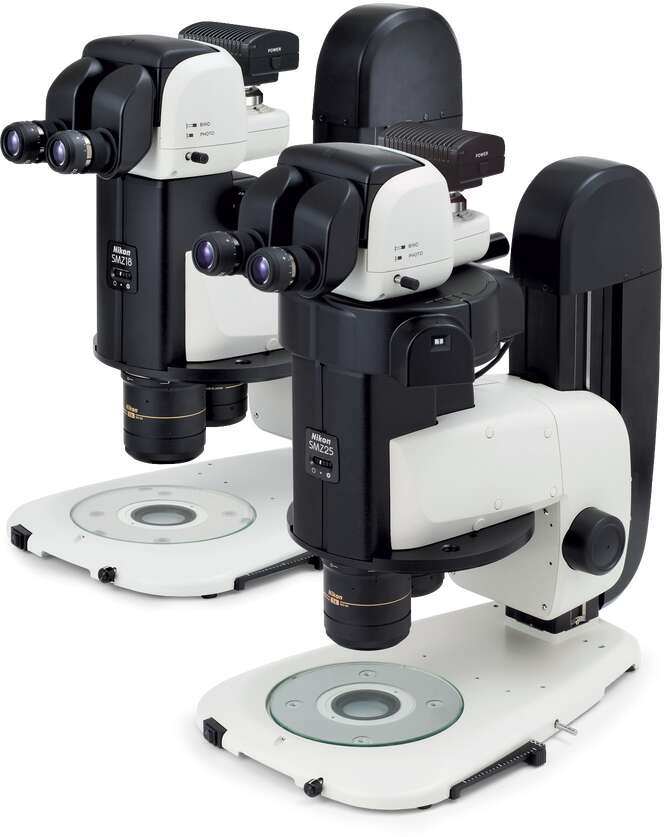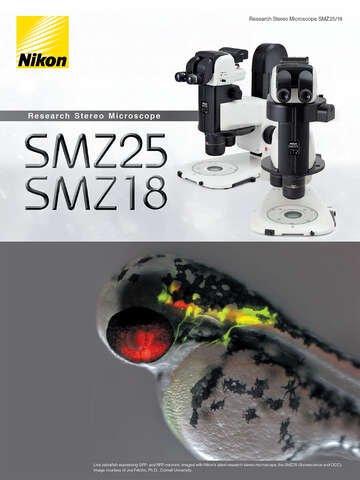Overview & Features
SMZ25 / SMZ18- Traditional boundaries between scientific fields such as molecular biology and developmental biology are rapidly disappearing as researchers seek to connect findings at the molecular level to those derived from cellular, tissue, and organismal studies. Fields including molecular biology, cell biology, neurobiology, embryology, developmental biology and systems biology have increasing needs for imaging systems that span spatial scales from single cells to whole organisms.
With these demands in mind, Nikon has developed a stereo microscope that features a large zoom ratio of 25:1, high resolution and exceptional fluorescence transmission capability.

Features
Large zoom range enables high resolution macro to micro imaging
An innovative optical system known as Perfect Zoom System makes it possible for the first time to achieve a zoom ratio of 25:1 (zoom range: 0.63X – 15.75X). Even with a 1X objective lens, the SMZ25 captures the entire 35mm dish and simultaneously delivers microscopic details.

(Using SHR Plan Apo 1X with SMZ25)
Image courtesy of Japan Insect Association
Nikon Perfect Zoom System offers new levels of imaging power and versatility
A breakthrough in stereo microscope design, Perfect Zoom System dynamically changes the distance between the two optical axes as the zoom factor is changed. This change in optical axis distance enables maximization of light entry into the optical system at every magnification. The result is an uncompromised, large zoom range, high resolution in both eye paths, and minimal aberrations over the entire zoom-range. Furthermore, this breakthrough in optical design enables all of these desirable features be housed in a compact zoom body, resulting in an ergonomic instrument design.
Great zoom range and high resolution
The SHR Plan Apo series objective lens offers a high resolution of 1100LP/mm (observed value, using SHR Plan Apo 2X at maximum zoom), delivering brilliant images with true-to-life colors.

Comparison of resolution and color aberration by resolution chart
 SMZ25
SMZ25 Conventional model
Conventional modelAuto Link Zoom (ALZ) supports seamless viewing at different scales
ALZ automatically adjusts the zoom factor to maintain the same field of view when switching objective lenses. This function enables seamless switching between whole organism imaging at low magnifications and detailed imaging at high magnifications.

Enhanced brightness and uniform illumination in low magnification range
The SMZ25 series is the first stereo microscope in the world to use a fly-eye lens on an epi-fluorescence attachment. This innovative design ensures bright and uniform illumination even at low magnifications, resulting in uncompromised uniformity in brightness across a large field of view.
Poor illumination coverage
Fly eye lens uniformly illuminates the entire field of view
Improved S/N ratio and crystal clear fluorescent images thanks to an improved optical system
Nikon’s newly developed optical system offers a drastic improvement in S/N ratio even at high magnifications. This improved S/N ratio makes it possible to capture low fluorescence signals and light-sensitive events such as cell division, which is difficult using conventional stereo microscopes.

Fluorescence and OCC images of a live C. elegans expressing GFP- and RFP-neurons
(using SHR Plan Apo 2X at zoom magnification of 3X with SMZ25)
Image courtesy of Julie C. Canman, Ph.D., Columbia University
Zoom body with significant improvements in optical performance
Nikon has succeeded in improving the signal and reducing noise in fluorescent images by using a short wavelength, high transmission lens. Combined with an innovative epi-fluorescence attachment, the SMZ18/25 is better able to detect emission signal than conventional fluorescent stereo microscopes.

Wide range of digital imaging capabilities
Easily obtain the information you need, such as Z drive position, zoom factor, objective lens, filter cube, and LED DIA brightness by using the Digital Sight series and NIS-Elements together with the microscope.
NIS-Elements Imaging Software
One software for all systems: NIS-Elements which is Nikon’s flagship, cross-platform imaging software can also be used with Nikon’s latest stereo microscope systems SMZ25 and SMZ18. NIS-Elements enables a wide range of advanced digital imaging capabilities.
Multichannel (multicolor)
Multiple fluorescent channels can be captured in conjunction with other imaging methods such as OCC or brightfield.


Individual cells resolved in a live drosophila embryo expressing GFP and mCherry (Using SHR Plan Apo 2X at zoom magnification of 8X with SMZ25)
Image courtesy of Max V. Staller, Ph.D., Clarissa Scholes, and Angela DePace, Ph.D., Harvard Medical School
Time-lapse
Easily setup a time-lapse imaging experiment with NIS-Elements.

Image courtesy of Joe Fetcho, Ph.D., Cornell University
Extended depth of focus (EDF)
Capture multiple high resolution images at different focal depths to create a single extended depth of focus image or quasi-3D image.




Image courtesy of Hisaya Kakinuma, Ph.D., Laboratory for Developmental Gene Regulation, Developmental Brain Science Group, RIKEN Brain Science Institute
Easy-to-use OCC illumination
The new LED DIA Base with a built-in OCC illuminator generates minimal heat, consumes very little power and is long-lived. This illuminator can enhance the contrast of uneven surfaces, such as that of an embryo.
 Conventional diascopic illumination
Conventional diascopic illumination OCC illuminator
OCC illuminatorZebrafish embryo (using SHR Plan Apo 1x at zoom magnification of 5x with SMZ18)
Image courtesy of Junichi Nakai, Ph.D. Saitama University Brain science Institute
The OCC illuminator can be controlled using a slide lever. Thanks to scales on the slide lever, the user can save and reproduce desired illumination levels. In addition, an OCC plate can be inserted into the illumination unit from the front and rear sides, so images with different shadow direction can be observed.

What is OCC illumination?
The acronym OCC stands for oblique coherent contrast (OCC), which is a form of oblique lighting method developed by Nikon. Compared to conventional diascopic illumination that illuminates directly from below, OCC illumination applies coherent light to samples in a diagonal direction, giving contrast to colorless and transparent sample structures.
Examples of OCC images
 OCC illumination
OCC illumination Standard transmitted illumination
Standard transmitted illuminationC. elegans using SHR Plan Apo 1X, at zoom magnification of 13.5X, SMZ18 with P-DSF32
Fiber Diascopic Illumination
Image courtesy of: Dr. Yoshiaki Furukawa
Associate Professor, Department of Chemistry, Faculty of Science and Technology,
Keio University
 OCC illumination
OCC illumination Standard transmitted illumination
Standard transmitted illumination1 day Zebrafish embryo using SHR Plan Apo 1X, at zoom magnification of 8X, SMZ18 with P-DSF32
Fiber Diascopic Illumination
 OCC illumination
OCC illumination Standard transmitted illumination
Standard transmitted illuminationFiber Diascopic Illumination
Image courtesy of:Hitoshi Okamoto, MD, PhD
Lab for Neural Circuit Dynamics of Decision Making RIKEN Center for Brain Science (CBS)
User-friendly remote controller
The remote controller provides easy access to zoom and focus controls and is designed for both right and left hand use. The remote controller contains an LCD monitor with an adjustable backlight which provides information regarding the zoom factor, objective lens, filter cube, and LED DIA brightness at a glance.
 The remote controller contains an LCD monitor with an adjustable backlight which provides information regarding the zoom factor, objective lease, filter cube, and LED DIA brightness at a glance.
The remote controller contains an LCD monitor with an adjustable backlight which provides information regarding the zoom factor, objective lease, filter cube, and LED DIA brightness at a glance.
On-axis imaging for digital images
Easily switch between stereo position (stereoscopic view) and mono position (on-axis view) when using the P2-RNI2 Intelligent Nosepiece by simply sliding the objective lens.
Note: The affiliations and information are accurate as of the time of publication.
Specifications
| Zooming body | SMZ25 | SMZ18 |
|---|---|---|
| Optical system | Parallel-optics type (zooming type), apochromatic optical system | |
| Zoom | Motorized | Manual |
| Zoom ratio | 25:1 | 18:1 |
| Zoom range | 0.63-15.75X | 0.75-13.5X |
| Aperture diaphragm | Zooming body built-in | |
| Objectives NA, WD (mm) | SMZ25 | SMZ18 |
|---|---|---|
| P2-SHR Plan Apo 2X | 0.312, 20 (with a correction ring for water 0 to 3 mm in depth) | 0.3, 20 (with a correction ring for water 0 to 3 mm in depth) |
| P2-SHR Plan Apo 1.6X | 0.25, 30 | 0.24, 30 |
| P2-SHR Plan Apo 1X | 0.156, 60 | 0.15, 60 |
| P2-SHR Plan Apo 0.5X | 0.078, 71 | 0.075, 71 |
| SMZ25 | SMZ18 | |
|---|---|---|
| Total Magnification (using 10X eyepieces) | 3.15-315X (Depending on objective used) |
3.75-270X (Depending on objective used) |
| Eyepieces (F.O.V. mm) | C-W 10XB (22) C-W 15X (16) C-W 20X (12.5) C-W 30X (7) |
|
| Tubes (eyepiece/port) | P2-TERG 100 Trinocular Tilting tube (100/0 : 0/100)
P2-TERG 50 Trinocular Tilting tube (100/0 : 50/50) Inclination angle : 0-30 degree |
|
| P2-TL100 Trinocular Tube L (100/0 : 0/100) Inclination angle : 10 degree | ||
| Focusing Unit (stroke from objective’s parfocal point) | P2-MFU Motorized Focus Unit (Up 96 mm/Down 4 mm)
P2-FU Focus Unit (Up 97 mm/Down 5 mm) |
|
| Focus mount adapter/nosepiece | P2-FM Focus Mount Adapter
P2-RNI2 Intelligent Nosepiece (2 objectives can be attached) |
P2-FM Focus Mount Adapter
P2-RNI2 Intelligent Nosepiece (2 objectives can be attached) P2-FMDN Focus Mount (for P-PS32, P-DSL32 and P-DFS32 stand) |
| Bases/stand | P2-PB Plain Base
P2-DBL LED Diascopic Illumination Base (OCC illuminator built-in) P2-DBF Fiber Diascopic Illumination Base P-PS32 Plain Stand* P-DSL32 Diascopic Illumination Stand* P-DFS32 Fiber Diascopic Illumination Stand* |
|
| Stages | P-SXY64 Stage
C-SSL Dia-sliding Stage C-TRS Tilting Stage |
|
| Epi-fluorescence attachments | 4 filter cubes mountable, Fly eye lens built-in | |
| P2-EFLM2 Motorized Epi Fluorescence Attachment
P2-EFLI2 Epi Fluorescence Attachment |
||
| Episcopic illuminators | P2-FIRL LED Ring Illumination Unit | |
| Use with Fiber light source
P2-CI Coaxial Epi Illuminator P2-FIR Ring Fiber Illumination Unit C-FDF Flexible Double Arm Fiber Illumination Unit |
||
| Episcopic light source | C-FLED2 LED Light source for fiber illuminator | |
| Observation methods | Bright Field, Epi Fluorescence, Simple Polarizing (with P2-POL Simple Polarizing Attachment), Dark Field (with P-DF LED Dark Field Unit), Oblique lighting | |
| Weight (approx.) | 32 kg (Motorized Epi Fluorescence Attachment configuration with Trinocular Tilting Tube, Motorized Focus Unit, Intelligent Nosepiece, LED DIA base and Objectives 1X and 0.5X) | 30 kg (Epi Fluorescence Attachment configuration with Trinocular Tilting Tube, Focus Unit, Intelligent Nosepiece, LED DIA base and Objectives 1X and 0.5X) |
| Power consumption (approx.) | 30 W (Motorized Epi Fluorescence Attachment configuration with Trinocular Tilting Tube, Motorized Focus Unit, Intelligent Nosepiece and LED DIA base) | 10 W (Epi Fluorescence Attachment configuration with Trinocular Tilting Tube, Focus Unit, Intelligent Nosepiece and LED DIA base) |
*Compatible with SMZ18 only


